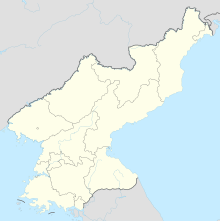
Back Primera Batalla de Maryang San Spanish Bataille de Maryang San French 제1차 마량산 전투 Korean First Battle of Maryang San SIMPLE
| First Battle of Maryang-san | |||||||
|---|---|---|---|---|---|---|---|
| Part of the Korean War | |||||||
 Maryang-san (right), Korea | |||||||
| |||||||
| Belligerents | |||||||
|
| |||||||
| Commanders and leaders | |||||||
|
|
| ||||||
| Units involved | |||||||
|
|
| ||||||
| Strength | |||||||
| 320 men | 1,200 men | ||||||
| Casualties and losses | |||||||
|
20 killed 104 wounded |
283 killed 50 captured | ||||||
Location within modern-day North Korea | |||||||
The First Battle of Maryang-san (3–8 October 1951), also known as the Defensive Battle of Maliangshan (Chinese: 馬良山防衛戰; pinyin: Mǎliáng Shān Fángyù Zhàn), was fought during the Korean War between United Nations Command (UN) forces—primarily Australian, British and Canadian—and the Chinese People's Volunteer Army (PVA). The fighting occurred during a limited UN offensive by US I Corps, codenamed Operation Commando. This offensive ultimately pushed the PVA back from the Imjin River to the Jamestown Line and destroyed elements of four PVA armies following heavy fighting.[Note 1] The much smaller battle at Maryang-san took place over a five-day period, and saw the 1st Commonwealth Division dislodge a numerically superior PVA force from the tactically important Kowang-san (Hill 355), Hill 187, and Maryang-san (Hill 317, a.k.a. Hill 315) features.
Using tactics first developed against the Japanese in New Guinea during the Second World War, the Australians gained the advantage of the high ground and assaulted the PVA positions from unexpected directions. They then repelled repeated PVA counterattacks aimed at re-capturing Maryang San and Kowang-san (the latter on 12 October), with both sides suffering heavy casualties before the Australians were finally relieved by a British battalion. However, with the peace-talks ongoing, these operations proved to be the last actions in the war of manoeuvre, which had lasted the previous sixteen months. It was replaced by a static war characterised by fixed defences reminiscent of the Western Front in 1915–17. A month later, the PVA re-captured Maryang San during fierce fighting, and it was never re-gained. Today, the battle is widely regarded as one of the Australian Army's greatest accomplishments during the war.
- ^ Chinese Military Science Academy 2000, p. 558.
- ^ Chinese Military Science Academy 2000, p. 559.
- ^ Hu & Ma 1987, p. 89.
Cite error: There are <ref group=Note> tags on this page, but the references will not show without a {{reflist|group=Note}} template (see the help page).
© MMXXIII Rich X Search. We shall prevail. All rights reserved. Rich X Search
